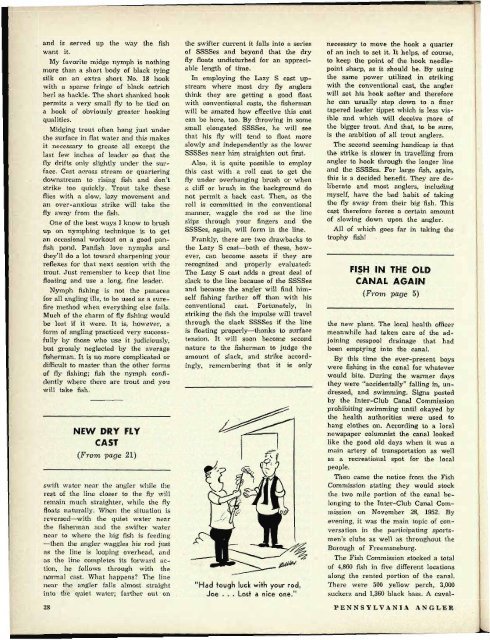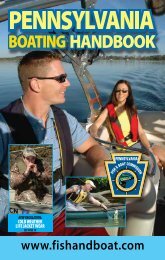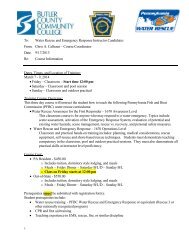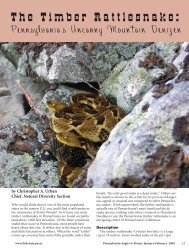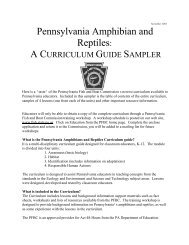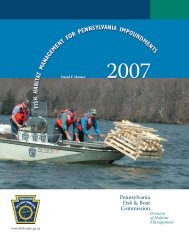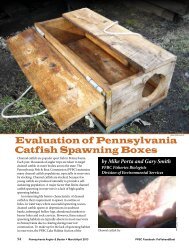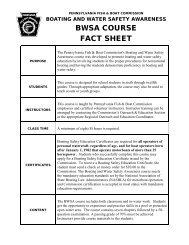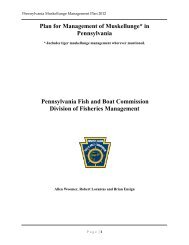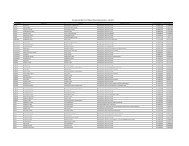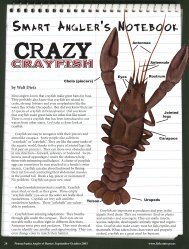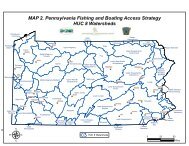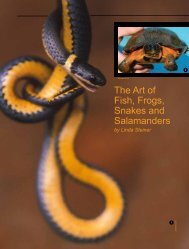pennsylvania angler 1953 - Pennsylvania Fish and Boat Commission
pennsylvania angler 1953 - Pennsylvania Fish and Boat Commission
pennsylvania angler 1953 - Pennsylvania Fish and Boat Commission
Create successful ePaper yourself
Turn your PDF publications into a flip-book with our unique Google optimized e-Paper software.
<strong>and</strong> is served up the way the fish<br />
want it.<br />
My favorite midge nymph is nothing<br />
more than a short body of black tying<br />
silk on an extra short No. 18 hook<br />
with a sparse fringe of black ostrich<br />
herl as hackle. The short shanked hook<br />
permits a very small fly to be tied on<br />
a hook of obviously greater hooking<br />
qualities.<br />
Midging trout often hang just under<br />
the surface in flat water <strong>and</strong> this makes<br />
it necessary to grease all except the<br />
last few inches of leader so that the<br />
fly drifts only slightly under the surface.<br />
Cast across stream or quartering<br />
downstream to rising fish <strong>and</strong> don't<br />
strike too quickly. Trout take these<br />
flies with a slow, lazy movement <strong>and</strong><br />
an over-anxious strike will take the<br />
fly away from the fish.<br />
One of the best ways I know to brush<br />
up on nymphing technique is to get<br />
an occasional workout on a good panfish<br />
pond. Panfish love nymphs <strong>and</strong><br />
they'll do a lot toward sharpening your<br />
reflexes for that next session with the<br />
trout. Just remember to keep that line<br />
floating <strong>and</strong> use a long, fine leader.<br />
Nymph fishing is not the panacea<br />
for all angling ills, to be used as a surefire<br />
method when everything else fails.<br />
Much of the charm of fly fishing would<br />
be lost if it were. It is, however, a<br />
form of angling practiced very successfully<br />
by those who use it judiciously,<br />
but grossly neglected by the average<br />
fisherman. It is no more complicated or<br />
difficult to master than the other forms<br />
of fly fishing; fish the nymph confidently<br />
where there are trout <strong>and</strong> you<br />
will take fish.<br />
NEW DRY FLY<br />
CAST<br />
(From page 21)<br />
swift water near the <strong>angler</strong> while the<br />
rest of the line closer to the fly will<br />
remain much straighter, while the fly<br />
floats naturally. When the situation is<br />
reversed—with the quiet water near<br />
the fisherman <strong>and</strong> the swifter water<br />
near to where the big fish is feeding<br />
—then the <strong>angler</strong> waggles his rod just<br />
as the line is looping overhead, <strong>and</strong><br />
as the line completes its forward action,<br />
he follows through with the<br />
normal cast. What happens? The line<br />
near the <strong>angler</strong> falls almost straight<br />
into the quiet water; farther out on<br />
the swifter current it falls into a series<br />
of SSSSes <strong>and</strong> beyond that the dry<br />
fly floats undisturbed for an appreciable<br />
length of time.<br />
In employing the Lazy S cast upstream<br />
where most dry fly <strong>angler</strong>s<br />
think they are getting a good float<br />
with conventional casts, the fisherman<br />
will be amazed how effective this cast<br />
can be here, too. By throwing in some<br />
small elongated SSSSes, he will see<br />
that his fly will tend to float more<br />
slowly <strong>and</strong> independently as the lower<br />
SSSSes near him straighten out first.<br />
Also, it is quite possible to employ<br />
this cast with a roll cast to get the<br />
fly under overhanging brush or when<br />
a cliff or brush in the background do<br />
not permit a back cast. Then, as the<br />
roll is committed in the conventional<br />
manner, waggle the rod as the line<br />
slips through your fingers <strong>and</strong> the<br />
SSSSes, again, will form in the line.<br />
Frankly, there are two drawbacks to<br />
the Lazy S cast—both of these, however,<br />
can become assets if they are<br />
recognized <strong>and</strong> properly evaluated:<br />
The Lazy S cast adds a great deal of<br />
slack to the line because of the SSSSes<br />
<strong>and</strong> because the <strong>angler</strong> will find himself<br />
fishing farther off than with his<br />
conventional cast. Fortunately, in<br />
striking the fish the impulse will travel<br />
through the slack SSSSes if the line<br />
is floating properly—thanks to surface<br />
tension. It will soon become second<br />
nature to the fisherman to judge the<br />
amount of slack, <strong>and</strong> strike accordingly,<br />
remembering that it is only<br />
"Had tough luck with your rod,<br />
Joe . . . Lost a nice one."<br />
necessary to move the hook a quarter<br />
of an inch to set it. It helps, of course,<br />
to keep the point of the hook needlepoint<br />
sharp, as it should be. By using<br />
the same power utilized in striking<br />
with the conventional cast, the <strong>angler</strong><br />
will set his hook softer <strong>and</strong> therefore<br />
he can usually step down to a finer<br />
tapered leader tippet which is less visible<br />
<strong>and</strong> which will deceive more of<br />
the bigger trout. And that, to be sure,<br />
is the ambition of all trout <strong>angler</strong>s.<br />
The second seeming h<strong>and</strong>icap is that<br />
the strike is slower in travelling from<br />
<strong>angler</strong> to hook through the longer line<br />
<strong>and</strong> the SSSSes. For large fish, again,<br />
this is a decided benefit. They are deliberate<br />
<strong>and</strong> most <strong>angler</strong>s, including<br />
myself, have the bad habit of taking<br />
the fly away from their big fish. This<br />
cast therefore forces a certain amount<br />
of slowing down upon the <strong>angler</strong>.<br />
All of which goes far in taking the<br />
trophy fish!<br />
FISH IN THE OLD<br />
CANAL AGAIN<br />
(From page 5)<br />
the new plant. The local health officer<br />
meanwhile had taken care of the adjoining<br />
cesspool drainage that had<br />
been emptying into the canal.<br />
By this time the ever-present boys<br />
were fishing in the canal for whatever<br />
would bite. During the warmer days<br />
they were "accidentally" falling in, undressed,<br />
<strong>and</strong> swimming. Signs posted<br />
by the Inter-Club Canal <strong>Commission</strong><br />
prohibiting swimming until okayed by<br />
the health authorities were used to<br />
hang clothes on. According to a local<br />
newspaper columnist the canal looked<br />
like the good old days when it was a<br />
main artery of transportation as well<br />
as a recreational spot for the local<br />
people.<br />
Then came the notice from the <strong>Fish</strong><br />
<strong>Commission</strong> stating they would stock<br />
the two mile portion of the canal belonging<br />
to the Inter-Club Canal <strong>Commission</strong><br />
on November 28, 1952. By<br />
evening, it was the main topic of conversation<br />
in the participating sportsmen's<br />
clubs as well as throughout the<br />
Borough of Freemansburg.<br />
The <strong>Fish</strong> <strong>Commission</strong> stocked a total<br />
of 4,860 fish in five different locations<br />
along the rented portion of the canal.<br />
There were 500 yellow perch, 3,000<br />
suckers <strong>and</strong> 1,360 black bass. A caval-<br />
28 PENNSYLVANIA ANGLER


